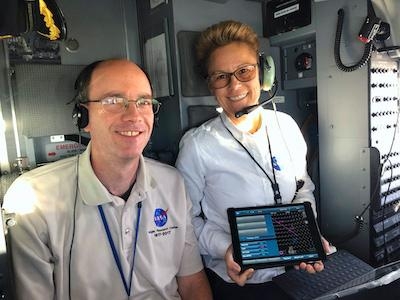Publication Recognizes Traffic Aware Strategic Aircrew Requests (TASAR) Project
The Traffic Aware Strategic Aircrew Requests (TASAR) project’s Traffic Aware Planner (TAP) software, developed by researchers at NASA’s Langley Research Center in Hampton, Virginia, was selected as one of the winners of the 2019 “R&D 100” awards.

The 100 winners of the award were announced by R&D World Magazine. Paul J. Heney, vice president and editorial director for R&D World said in a press release that ‘these 100 winning products and technologies are the disruptors that will change industries and make the world a better place in the coming years.’
TAP enables aircraft operators to implement NASA’s TASAR concept, a patented method for generating flight-optimizing aircraft trajectories from the cockpit.
“TASAR applies onboard route optimization technology with connectivity to operational data to help flights achieve greater efficiency under dynamic airspace conditions,” said David Wing, TASAR project lead and principal investigator in NASA Langley’s Crew Systems and Aviation Operations Branch. “This optimizing software is flexible and can be updated by the pilot during a flight to save fuel, flight time, or net operating cost.”
By using air-to-air traffic information received by Automatic Dependent Surveillance Broadcast (ADS-B), as well as ground-based information on wind speeds, weather, restricted airspace status, and other Air Traffic Control (ATC) constraints, TAP integrates all these environment factors and constraints into its computation of route-improvement options for the pilot to review. “The pilot may then make a route-change request, based on TAP recommendations, to ATC using standard voice-request procedures,” said Wing. “Because TAP-generated solutions incorporate traffic avoidance and other operational constraints, they are more likely to be approved by ATC and therefore more likely to result in actual benefits by the aircraft operator.”

Following initial testing through two NASA flight trials, TAP was operationally evaluated by Alaska Airlines in revenue service. The airline conducted 119 flights in late 2018 and early 2019 with TAP onboard. From both Alaska’s and NASA’s perspective, the operational evaluation was successful. Alaska has identified a commercial industry team to take the next steps toward their goal of fleet-wide deployment and have announced their plans at industry forums.
TAP’s powerful in-flight route-optimization capability, using multiple degrees of lateral and vertical freedoms, significantly expands on currently available capabilities of an aircraft’s Flight Management System while driving a low-cost implementation on Electronic Flight Bags that appeals to early adopters.
The technology also has many growth opportunities such as incorporating additional data on the flight environment (e.g., turbulence) and connectivity to ATC’s emerging data communications program. “Following Alaska’s successful evaluation, several additional airlines have initiated discussions with NASA and the commercial companies licensing the NASA technology,” said Wing. “These developments are positive indicators of potential widespread industry adoption of TASAR.”
By establishing a future autonomy infrastructure such as cockpit-based automation with connectivity to on- and off-board data, and by transforming aircrews into proactive managers of their trajectories, TAP represents a significant innovation to aerospace. “This application of TASAR catalyzes a path towards operational autonomy for future aircraft operators, while providing today's operators with a direct operational benefit of taking this initial but critical first step toward that future,” said Wing.
The R&D 100 awards banquet will be held Thursday, December 5th, at the San Mateo Marriott near San Francisco, California.
(Images provided with NASA news release)
 Airbus Racer Helicopter Demonstrator First Flight Part of Clean Sky 2 Initiative
Airbus Racer Helicopter Demonstrator First Flight Part of Clean Sky 2 Initiative Diamond's Electric DA40 Finds Fans at Dübendorf
Diamond's Electric DA40 Finds Fans at Dübendorf ANN's Daily Aero-Term (04.23.24): Line Up And Wait (LUAW)
ANN's Daily Aero-Term (04.23.24): Line Up And Wait (LUAW) NTSB Final Report: Extra Flugzeugbau GMBH EA300/L
NTSB Final Report: Extra Flugzeugbau GMBH EA300/L Classic Aero-TV: 'Never Give Up' - Advice From Two of FedEx's Female Captains
Classic Aero-TV: 'Never Give Up' - Advice From Two of FedEx's Female Captains




